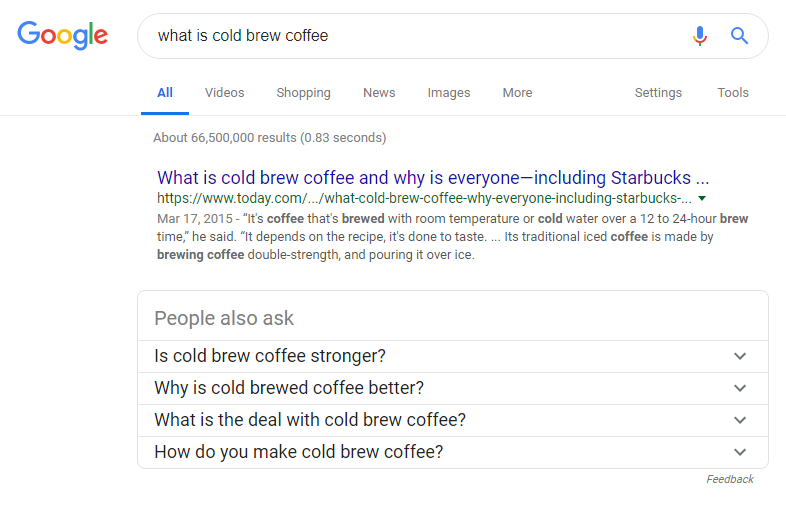Google Box changes how search results work by placing selected content at the top, making it more visible and credible. Websites that rank here gain a strong advantage, but securing that ranking requires understanding how Google selects content and shaping your approach to meet those standards. Let’s look at what the Google Box is, why it matters for SEO, and how you can best take advantage of it with your content.
What Is the Google Box?
The Google Box, also known as a featured snippet, appears before traditional search results. It takes information from a website and presents it as a direct answer to a question. They come in several formats, like paragraphs, lists, tables, or videos.
Ever wonder why some pages land in Google’s top spot while others don’t? The answer has to do with how content is structured. To see if a query has a featured snippet, search your target keyword in Google. If you see a box at the top, analyze its structure and improve upon it.
Google loves four main snippet formats:
- Paragraph: A short block of text answering a direct question.
- List: Bulleted or numbered points, often for step-by-step guides.
- Table: A structured format used for data comparisons.
- Video: A clip that directly addresses the query, often pulled from YouTube.
Understanding these formats lets you align your content with Google’s selection criteria.
Why Google Box Matters for SEO
A featured snippet demonstrates authority. When Google highlights content, users see it as a trusted source.
Think your content is optimized for snippets? Let’s find out.
The placement at the top increases visibility. Standard search results compete for attention, but the Google Box comes before them all. In fact, featured snippets get 8% of all clicks.
They hold even more weight for voice search. Virtual assistants tend to take responses from featured snippets, so those pages have an edge.
Brand recognition also improves. Seeing your content in top results strengthens users’ association with your brand.
How to Optimize for the Google Box
Earning a spot in the Google Box depends on content clarity, structure, and strong SEO practices. Here’s how to improve your chances.
Find the Right Queries
Featured snippets often answer specific questions in a Google Box. There are several tools, like Google’s People Also Ask section, that help with researching common queries in your industry.
Focus on long-tail keywords such as:
- “How does Google Box work?”
- “What improves Google Box rankings?”
Look at existing snippets for those searches. Study their structure. Find ways to refine or expand on that information.
Structure Content for Clarity
Google likes content that’s easy to read. Breaking text into sections with headers (H2, H3) organizes it, making it easier to read.
Some searches work best with lists or step-by-step formats. Others fit tables or short paragraphs. Choose a structure that matches the question.
Before Optimization:
“A featured snippet is a search result that Google selects based on relevance and clarity. Many businesses aim for this position.”
After Optimization:
“A featured snippet is a search result that appears at the top of Google, providing a direct answer to a query.”
By making answers direct and skimmable, you increase your chances of being selected.
Answer Directly and Early
Google prioritizes clear, direct answers. The faster you get to the point, the higher your chances of landing in the Google Box.
For example, when explaining “What is the Google Box?”, start with a simple definition:
“The Google Box, or featured snippet, is a search result that Google selects to provide a direct answer to a user’s query.”
Then, expand on supporting details. This way, the response is kept sharp while providing enough depth.
Optimize Existing Pages
If your site ranks on the first page but isn’t featured, small adjustments might push it into the Google Box. Restructure key sections. Use a question-answer format where possible.
Review competitors who hold the featured snippet. Identify patterns in their content and improve on those elements to enhance your ranking.
Strengthen On-Page SEO
Strong SEO signals help Google recognize valuable content. Use relevant keywords throughout headings and text. Include variations such as:
- “Google featured snippet”
- “SEO rankings”
- “organic search placement”
Meta descriptions dictate how users engage with your content. A clear, compelling summary encourages clicks, reinforcing relevance for Google.
Instead of:
“Now is the time to apply these strategies and optimize your content for Google Box rankings.”
Try:
“Want to dominate Google’s search results? Start implementing these steps today and secure your spot at the top.”
Build Credibility with Backlinks
Google favors authoritative sources, so strong backlinks from reputable sites make you more credible.
Fresh content also plays a role. If a page held a snippet but lost it, you might reclaim it just by updating the content.
Improve Site Performance
A slow or unresponsive site won’t rank or see any success. Google prioritizes fast, mobile-friendly pages.
Run a speed test using tools like Google PageSpeed Insights. Compress images, simplify code, and use a responsive design to improve user experience and boost rankings.
Adjust Formatting as Needed
Google Box results appear in different formats. If content isn’t ranking in a paragraph snippet, reformat it as a list or table.
Test different structures to see what works. A slight change in layout can make a big difference.
Monitor and Adapt
SEO requires ongoing adjustments. Google refines its algorithm, and ranking factors shift over time.
To track performance:
- Log into Google Search Console.
- Navigate to the Performance tab.
- Filter for queries where your site ranks in the top 10.
- Compare your content with the snippet holder’s structure.
- If a competitor replaces you, refine your content for clarity and completeness.
Ranking in the Google Box requires well-structured, clear content and strong SEO. Consistently monitoring your results ensures you maintain visibility.
TL;DR: How to Rank in the Google Box
- Target Question-Based Keywords – Use “People Also Ask” and long-tail phrases.
- Structure Content Clearly – Use lists, tables, and concise paragraphs.
- Optimize for On-Page SEO – Add schema markup and strong keyword integration.
- Improve Load Speed – Optimize performance for faster ranking.
- Monitor & Adapt – Track rankings in Google Search Console.
Secure Your Spot in the Google Box
Thinking inside the box isn’t limiting—it’s a way to stand out. By structuring answers clearly, strengthening SEO, and refining content, you increase your chances of securing this prime spot.
Want to dominate Google’s search results? Start implementing these steps today and secure your place at the top.





